- Region
- Águilas
- Alhama de Murcia
- Jumilla
- Lorca
- Los Alcázares
- Mazarrón
- San Javier
-
ALL AREAS & TOWNS
- AREAS
- SOUTH WEST
- MAR MENOR
- MURCIA CITY & CENTRAL
- NORTH & NORTH WEST
- TOWNS
- Abanilla
- Abarán
- Aguilas
- Alamillo
- Alcantarilla
- Aledo
- Alhama de Murcia
- Archena
- Balsicas
- Blanca
- Bolnuevo
- Bullas
- Cañadas del Romero
- Cabo de Palos
- Calasparra
- Camping Bolnuevo
- Campo De Ricote
- Camposol
- Canada De La Lena
- Caravaca de la Cruz
- Cartagena
- Cehegin
- Ceuti
- Cieza
- Condado de Alhama
- Corvera
- Costa Cálida
- Cuevas De Almanzora
- Cuevas de Reyllo
- El Carmoli
- El Mojon
- El Molino (Puerto Lumbreras)
- El Pareton / Cantareros
- El Raso
- El Valle Golf Resort
- Fortuna
- Fuente Alamo
- Hacienda del Alamo Golf Resort
- Hacienda Riquelme Golf Resort
- Isla Plana
- Islas Menores & Mar de Cristal
- Jumilla
- La Azohia
- La Charca
- La Manga Club
- La Manga del Mar Menor
- La Pinilla
- La Puebla
- La Torre
- La Torre Golf Resort
- La Unión
- Las Palas
- Las Ramblas
- Las Ramblas Golf
- Las Torres de Cotillas
- Leiva
- Librilla
- Lo Pagan
- Lo Santiago
- Lorca
- Lorquí
- Los Alcázares
- Los Balcones
- Los Belones
- Los Canovas
- Los Nietos
- Los Perez (Tallante)
- Los Urrutias
- Los Ventorrillos
- Mar De Cristal
- Mar Menor
- Mar Menor Golf Resort
- Mazarrón
- Mazarrón Country Club
- Molina de Segura
- Moratalla
- Mula
- Murcia City
- Murcia Property
- Pareton
- Peraleja Golf Resort
- Perin
- Pilar de la Horadada
- Pinar de Campoverde
- Pinoso
- Playa Honda
- Playa Honda / Playa Paraíso
- Pliego
- Portmán
- Pozo Estrecho
- Puerto de Mazarrón
- Puerto Lumbreras
- Puntas De Calnegre
- Region of Murcia
- Ricote
- Roda Golf Resort
- Roldan
- Roldan and Lo Ferro
- San Javier
- San Pedro del Pinatar
- Santiago de la Ribera
- Sierra Espuña
- Sucina
- Tallante
- Terrazas de la Torre Golf Resort
- Torre Pacheco
- Totana
- What's On Weekly Bulletin
- Yecla


- EDITIONS:
 Spanish News Today
Spanish News Today
 Alicante Today
Alicante Today
 Andalucia Today
Andalucia Today
Cehegín, Iglesia Mayor De Santa María Magdalena
Iglesia Mayor De Santa María Magdalena (15th and 16th centuries)
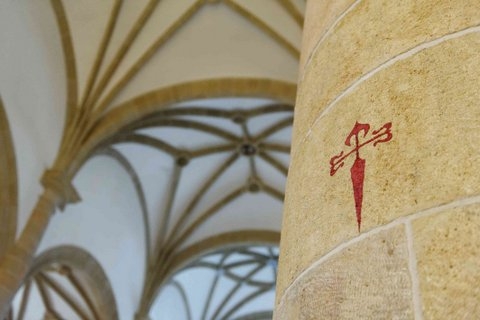 Dominating the skyline of the old quarter, this is the most emblematic church in Cehegín.
Dominating the skyline of the old quarter, this is the most emblematic church in Cehegín.
Before the Treaty of Alcárez was signed in 1243, Cehegin had been occupied by Muslim Moors for around 500 years, and had a mosque as its central point of worship. It was common practise at this time to "recycle" existing buildings, and this situation occurred in Cehegín: until the 14th century a painted statue of Mary Magdalene was worshipped in the town’s mosque, and later on the mosque was rebuilt by the Christians to become a church in its own right.
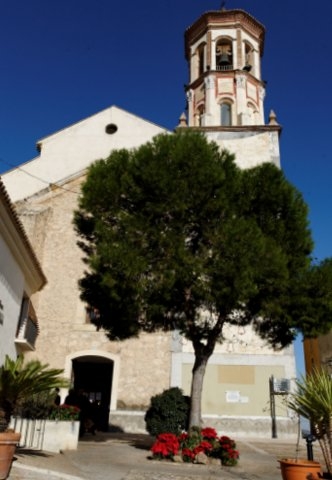 The first documentary mention of the church dates from 1467, when Juan Bellón, the warden of the fortress of Cehegín, is documented as swearing loyalty to Juan Pacheco, the Master of the Order of Santiago, ( Click for more info, Order of Santiago) in its interior.
The first documentary mention of the church dates from 1467, when Juan Bellón, the warden of the fortress of Cehegín, is documented as swearing loyalty to Juan Pacheco, the Master of the Order of Santiago, ( Click for more info, Order of Santiago) in its interior.
Throughout the period when Cehegín was under the ownership of this religious and military Order, from the 14th to the 19th century, the Magdalena was the main church in the town, and was remodeled and extended in the second half of the 16th century following the designs prepared by the architect Jerónimo Quijano. It was at this point that the old 15th-century church acquired most of the features that we can still see today.
The first basic design was by Jerónimo Quijano, who at the same time was working on the Cathedral in Murcia, the Colegiata in Lorca, the El Salvador church in Caravaca and the Asunción church of Moratalla. This design was presented to the leaders of the Order of Santiago in 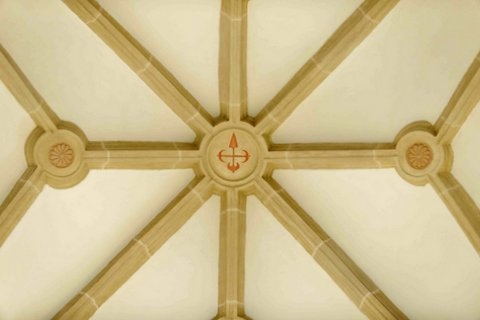 1526, and the initial project included Renaissance elements such as a straight-line floor plan and the use of supporting columns. However, possibly for reasons of finance and also as a result of the death of Quijano, the project was laid aside until 1576, when the master stonemason Ginés de Gea took over the construction. He recruited other professional masons to his team, including Pedro Negrete, Alonso Valero and Juan de Quintana.
1526, and the initial project included Renaissance elements such as a straight-line floor plan and the use of supporting columns. However, possibly for reasons of finance and also as a result of the death of Quijano, the project was laid aside until 1576, when the master stonemason Ginés de Gea took over the construction. He recruited other professional masons to his team, including Pedro Negrete, Alonso Valero and Juan de Quintana.
It is believed that De Gea revised Quijano’s plans, making the central nave higher and leaving the ionic capitals of the eight columns but placing on top of them other columns, with Tuscan capitals. This elevation of the main structure gives the church its sensation of inner space when 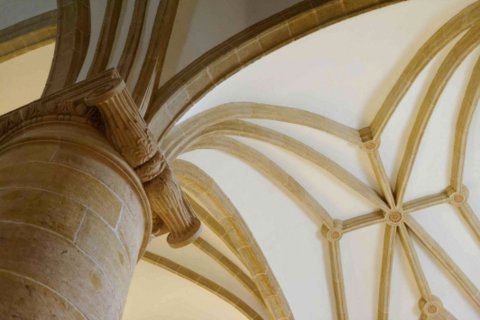 viewed from the main door.
viewed from the main door.
In the side naves, over the arches which rest on the ionic capitals, walls were built and decorated with stained glass windows, although these were subsequently bricked in. The research of Francisco Gómez Ortín has shown that the penultimate phase of construction was undertaken by the Villena-born architect Francisco Marín Monsalve, who left the town under strange circumstances, taking with him money from the construction project according to the regional archives of 1695. Following this interruption the final phase was overseen by the architects Francisco Bastida and José García, both from Lorca, who finally completed the building in 1698.
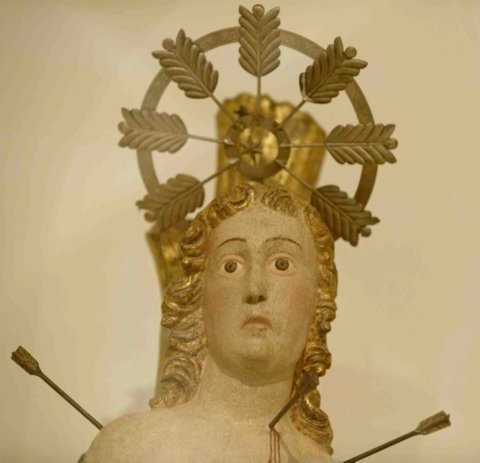 In 1768, the contract for the construction of the bell-tower was awarded to Martín Jiménez de la Fuente, who had to modify part of the right-hand nave and destroy the chapel of San Antón, which had been built to house the tomb of Fernando Alvarez Fajardo and his wife, in order to build the tower in the limited space available. The main bell was installed in the tower in 1798.
In 1768, the contract for the construction of the bell-tower was awarded to Martín Jiménez de la Fuente, who had to modify part of the right-hand nave and destroy the chapel of San Antón, which had been built to house the tomb of Fernando Alvarez Fajardo and his wife, in order to build the tower in the limited space available. The main bell was installed in the tower in 1798.
One of the most important works of art inside is the “Piedad” by Roque López, which is popularly known as the Virgen de las Angustias, and is one of the most impressive figures paraded in the Cehegín Easter processions. There is also a figure of San Sebastian by an unknown sculptor which dates from the 17th century.
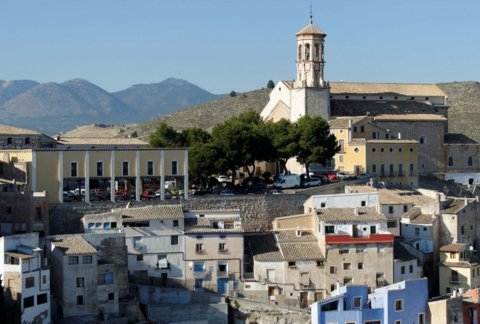 Most of the other sculptures are more modern works, replacements for pieces burnt during the Civil War.
Most of the other sculptures are more modern works, replacements for pieces burnt during the Civil War.
The ashlar work comes from the Cabezo de Roenas (Begastri) and on the south-east façade there is an inscription on stone dating from the 1st or 2nd century, which reads “M.FULVIUS M.L. FLACCUS HIC SITUS EST”.
Another important item within this church is the replica of the Cross of Cehegín which is in the centre of the main alterpiece, a simple bronze cross. Begastri, which lies 2 km from Cehegín was an important Visigoth City and an Episcopal seat. The original of this cross was found at this site and is believed to date from the 6th century. Click Cross of Cehegín.
The surrounding terrain and the limits of the old fortress determined the exterior finishing of the building, the overall effect being one of elegant simplicity. The lower part of this doorway is an arch surrounded by pilasters, and at the top there is a niche flanked by pinnacles. The effect is completed by a pediment on which there stands a sculpture of the patron saint of the church, San Crispín.
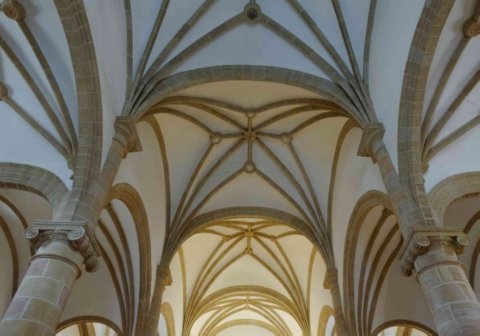 Guided tours for visitors are offered every 20 minutes from 11.00 to 13.30 Tuesdays to Thursdays, from 11.00 to 13.30 and 16.00 to 18.00 on Fridays and Saturdays, and from 10.00 to 12.00 and 12.30 to 13.30 on Sundays. Price 2 euros.
Guided tours for visitors are offered every 20 minutes from 11.00 to 13.30 Tuesdays to Thursdays, from 11.00 to 13.30 and 16.00 to 18.00 on Fridays and Saturdays, and from 10.00 to 12.00 and 12.30 to 13.30 on Sundays. Price 2 euros.
NB The guide only offers spanish language tours, so charges 1 euro for non-spanish visitors to enter, their contribution helping with the incessant maintenance required to upkeep the building.
Where is the Iglesia Mayor De Santa María Magdalena, Cehegín?
The church is on the corner of Calle de la Iglesia and Plaza de la Constitución. There is parking in the Plaza, indeed this is probably the best place to drive up to and park if intending to explore the old quarter of town. This is right next to the Archaeological Museum as well, and there are several bars and cafés nearby for a relaxing coffee in-between sightseeing.
Click for map, Iglesia Mayor De Santa María Magdalena, Cehegín
Click for details of services in all Cehegín churches.
For full information about Cehegín, go to the dedicated Cehegín section, Click Cehegín.
Cartagena
El Carmoli
Islas Menores and Mar de Cristal
La Manga Club
La Manga del Mar Menor
La Puebla
La Torre Golf Resort
La Union
Los Alcazares
Los Belones
Los Nietos
Los Urrutias
Mar Menor Golf Resort
Pilar de la Horadada
Playa Honda / Playa Paraiso
Portman
Roldan and Lo Ferro
San Javier
San Pedro del Pinatar
Santa Rosalia Lake and Life resort
Terrazas de la Torre Golf Resort
Torre Pacheco
Aledo
Alhama de Murcia
Bolnuevo
Camposol
Condado de Alhama
Fuente Alamo
Hacienda del Alamo Golf Resort
Lorca
Mazarron
Puerto de Mazarron
Puerto Lumbreras
Sierra Espuna
Totana
Abaran
Alcantarilla
Archena
Blanca
Corvera
El Valle Golf Resort
Hacienda Riquelme Golf Resort
Lorqui
Molina de Segura
Mosa Trajectum
Murcia City
Peraleja Golf Resort
Ricote
Sucina
Condado de Alhama
El Valle Golf Resort
Hacienda del Alamo Golf Resort
Hacienda Riquelme Golf Resort
Islas Menores and Mar de Cristal
La Manga Club
La Torre Golf Resort
Mar Menor Golf Resort
Mazarron Country Club
Mosa Trajectum
Peraleja Golf Resort
Santa Rosalia Lake and Life resort
Terrazas de la Torre Golf Resort
La Zenia
Lomas de Cabo Roig

CAMPOSOL TODAY Whats OnCartagena SpainCoronavirusCorvera Airport MurciaMurcia Gota Fria 2019Murcia property news generic threadWeekly Bulletin



